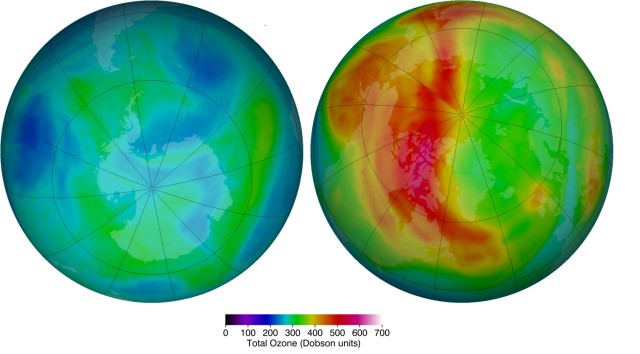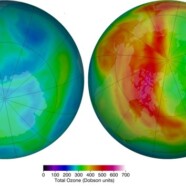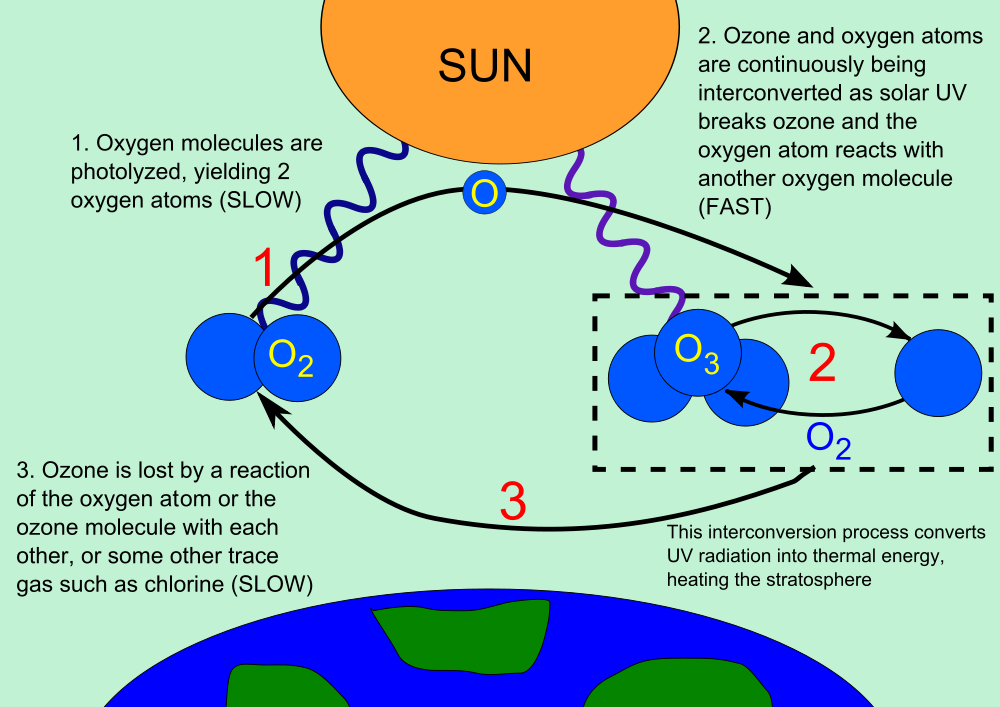Scientists Identify Four New Ozone Depleting Gases in Atmosphere
Scientists Identify Four New Ozone Depleting Gases in Atmosphere
Scientists have identified four new man-made gases in the atmosphere that they say are helping to destroy Earth’s protective ozone layer.
Writing in Nature Geoscience, the researchers said that there are about 74,000,000 kilograms of three newly identified chlorofluorocarbons (CFCs) – compounds that only contain the atoms of carbon, fluorine and chlorine – and one new hydrochlorofluorocarbons (HCFC) – hydrogen, carbon, fluorine and chlorine – that have been released into our atmosphere.

The false-color view of total ozone over the Antarctic pole (l) and Arctic pole (r) on March 6, 2014. The purple and blue colors are where there is the least ozone, and the yellows and reds are where there is more ozone. (NASA)
The ozone layer, located between the upper troposphere and lower stratosphere, contains a high concentration of an inorganic compound called ozone or trioxygen in the atmosphere. The ozone layer provides all life on Earth with protection from the harmful effects of the Sun’s radiation.
The gasses were identified by the group of scientists as CFC-112 (Tetrachloro-1, 2 – difluoroethane or Freon-112), CFC-112a (Tetrachloro-1, 1 – difluoroethane or Freon-112a), CFC-113a (1, 1, 1 – Trichloro – 2, 2, 2 – trifluoroethane or Freon-113a) and HCFC-133a (Monochlorotrifluoroethane).
The HCFCs are a group of man-made gases that were developed to replace CFC gases as refrigerants and aerosol propellants. The production of HCFCs grew in the 1980s after nations agreed to phase out the use of CFCs.
While they were considered to be less harmful to the environment than CFCs, HCFCs sometimes referred to as “super greenhouse gases” are also very potent greenhouse gases, despite being in very low concentrations in the atmosphere.
The researchers were able to make their findings by comparing samples of today’s air with air that has been trapped within polar “firn snow”, or the accumulation of snow leftover from previous years, as well as unpolluted air that was sampled between 1978 and 2012 in Tasmania. The scientists say the polar “firn snow” provided them with a natural archive of the atmosphere that dates back to about a century ago.
Measurements taken by the scientists indicated that all four of the new ozone layer-destroying gases have been released into the atmosphere recently but two them are amassing greatly.
The researchers said that the increase in emissions of the CFCs they studied have not been observed with any other CFC gases since the 1990s when stricter controls were introduced. But they do add that the current emissions are nowhere near the 1980s when the discharge of CFCs was at their peak with around 100,000,000 kilograms of the gases released each year.
“Our research has shown four gases that were not around in the atmosphere at all until the 1960s which suggests they are man-made,” said the study’s lead researcher Johannes Laube from University of East Anglia.
CFC compounds have been identified as the key source of the hole in the ozone layer over Antarctica.
In order to protect the ozone layer, a number of nations around the world signed or ratified the Montreal Protocol on Substances that Deplete the Ozone Layer in 1987 and the agreement went into effect in 1989. The international agreement sought to reduce and eventually phase out the use of CFCs by 2010.
Many consider the Montreal Protocol to be one of the most successful international agreements ever reached. The atmospheric concentrations of the most harmful CFCs have leveled off or at least have been decreased as a result, but there are various loopholes in the legislation that still allow usage of the CFCs for exempted purposes.
“The identification of these four new gases is very worrying as they will contribute to the destruction of the ozone layer,” said Laube. “We don’t know where the new gases are being emitted from and this should be investigated. Possible sources include feedstock chemicals for insecticide production and solvents for cleaning electronic components.”
Laube said that even if CFC emissions were to stop immediately, their presence would still be detected for many decades to come.


